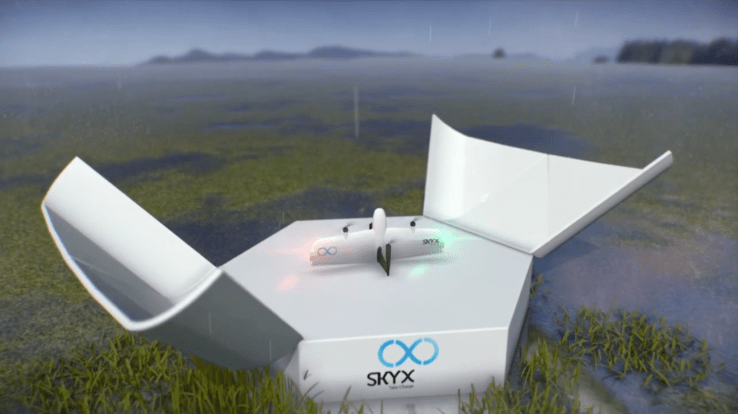A Markham, Ontario startup called SkyX Ltd. emerged from stealth today to share with TechCrunch details about its unique industrial drone designs. The company’s SkyOne drones take off and land like a helicopter, but fly more like an airplane, with a range of more than 25 miles (40 km) per charge. For drone industry nerds, this means they have both VTOL and fixed-wing elements.
A range of cameras and sensors on board enable SkyOne drones to gather data about infrastructure below and send it back to cloud-based applications for analysis. The drones also launch from and land on proprietary charging stations, called xStations, which close a kind of shell over the UAVs when they are not moving, protecting them from theft. The charging stations do not remove and replace the batteries within the drones, but charge them directly, then send the drones on their way.
Other companies, including Matternet, land their unmanned aerial vehicles on charging stations where their batteries are swapped out for fresh ones. Positioning charging stations along a route can give drones a virtually unlimited range. It’s a design idea we should expect to see until battery tech and other power systems advance significantly.
SkyX founder and CEO Didi Horn spent his earlier career flying for the Israel Air Force. He told TechCrunch, “I always knew I wanted to develop something around drones and aviation for commercial use when I got out. But in consumer there were already great products. There was nothing great for long-range, but that’s where I knew there would be demand. There are millions of kilometers of oil and gas pipelines already built in the world today and they are all at risk of leaks, or terror attacks, you name it.”
SkyX is targeting the energy industry first, as its drones and charging stations can be configured to cover long distances between pumping stations along oil and gas pipelines. The drones also can be used to cover acres of solar panels installed on vast farms, or wind turbines installed along roads, even in remote areas, Horn explained. The xStations can plug into a typical electric outlet. Or they can be connected to solar panels or other freestanding generators, he noted.
While the company did not have permission to disclose the names of its earliest customers, it is working with several energy companies on safety tests and pilot projects today in the Americas, Horn said. The drones fly autonomously, and the company also has to secure permission in different markets to fly beyond the line of sight of human observers or pilots on the ground.
SkyX only shared renderings and photos of a prototype. The CEO voiced concern over intellectual property, but says the drones are being used in the field today with some features still under development.


Comments
Post a Comment